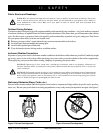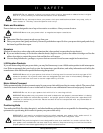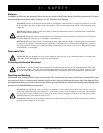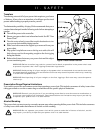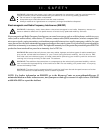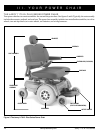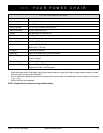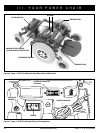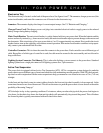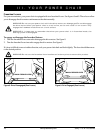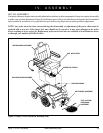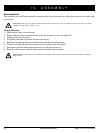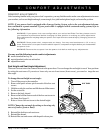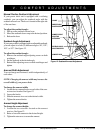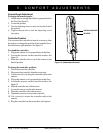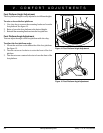
Jazzy 1170 XL Plus Series www.pridemobility.com 17
Electronics Tray
The electronics tray is located on the back of the power base. See figures 6 and 7. The ammeter, charger power cord, the
main circuit breaker, and controller connectors are all located on the electronics tray.
Ammeter: The ammeter displays the charger’s current output in amps. See VI. “Batteries and Charging.”
Charger Power Cord: The charger power cord plugs into a standard electrical outlet to supply power to the onboard
battery charger during battery charging.
Main Circuit Breaker: The main circuit breaker is a safety feature built into your power chair. When the batteries and the
motors are heavily strained (e.g., from excessive loads), the main circuit breaker trips to prevent damage to the motors and
the electronics. If the circuit trips, allow your power chair to “rest” for approximately one minute. Next, push in the circuit
breaker button, turn on the controller, and continue normal operation. If the main circuit breaker continues to trip repeat-
edly, contact your authorized Pride Provider.
Controller Connector: This is where the controller connects to the power base. Each controller uses a different type of
cable. Regardless of which type of controller is used, the cable must be secured to the seat assembly and not allowed to
drag on the floor.
Lighting System Connector (Not Shown): This is where the lighting system connects to the power base. Standard
lighting systems have a single pin connector. Full lighting systems use a 3-pin connector.
Active-Trac Suspension
The power chair is equipped with an Active-Trac Suspension (ATS). ATS is a suspension system designed to make the
power chair traverse different types of terrain and obstacles while maintaining smooth operation. With ATS, the front anti-
tip wheels work in conjunction with the motor suspension to help you maneuver over obstacles in excess of 3 in. (7.62 cm)
in height.
As the front anti-tip wheels come in contact with an obstacle, the front anti-tip wheel assembly is drawn upward. At the
same time, the motors are forced downward. This allows the motors to push the power chair over an obstacle without the
possibility of becoming “hung up.”
ATS also helps in day-to-day operating conditions. For instance, when you release the joystick, the power chair begins to
slow down. As the chair slows down, the front anti-tip wheels will automatically drop toward the ground. This will reduce
the forward tip that is typically encountered with mid-wheel drive chairs.
III. YOUR POWER CHAIR



